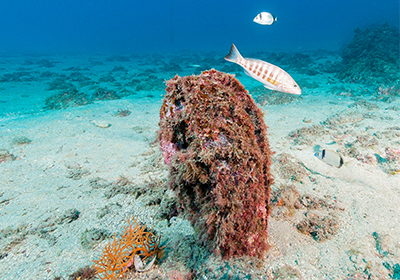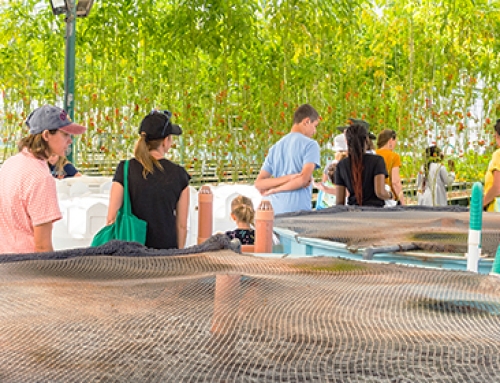In recent years, mass mortality of the noble pen shell (Pinna nobilis), a marine bivalve mollusc, has been reported in the Mediterranean, with an outbreak lately confirmed in the Venetian Lagoon area.
Researchers from the National Reference Centre for Fish, Crustacean and Mollusc Pathology of the Istituto Zooprofilattico Sperimentale delle Venezie (IZSVe), in collaboration with other research institutes, have investigated the issue through a field study. The main cause of mortality is the protozoa Haplosporidium pinnae in synergy with bacteria of the genus Mycobacterium. The findings have been published in the journal, Frontiers in Marine Science.
Pinna nobilis or noble pen shell

In recent years, mass mortality of the noble pen shell (Pinna nobilis), a marine bivalve mollusc, has been reported in the Mediterranean, with an outbreak lately confirmed in the Venetian Lagoon area.
Pinna nobilis, also called the noble pen shell, mussel pen or fan mussel, is a wild bivalve mollusc, originating in the Mediterranean Basin and Black Sea. It is a sessile species, i.e. it is immobile, living attached to sand or anchored to rocks, and well-known to marine enthusiasts for the considerable sizes to which it can grow.
Its presence in the Mediterranean Basin dates back to the Ancient Egyptian era, when it was collected for its byssus, a sort of biological thread resembling silk, secreted by the mussel and considered very precious at the time. Pinna nobilis is now in danger of extinction, making it a protected species whose collection is prohibited.
Mortality events in the Mediterranean Basin
The first mortality events among Pinna nobilis were reported along the Mediterranean coasts of Spain in the autumn of 2016. Similar cases are now reported on a daily basis throughout the Mediterranean, including Italy, Greece, France and Croatia.
Initially, the protozoan parasite Haplosporidium pinnae seemed to be the sole cause of the losses observed along the Spanish coasts. However, in some cases, as on the coasts of Campania and Sicily, mortality events also occurred in the absence of Haplosporidium pinnae, but in the presence of Mycobacterium sherrisii, which causes systemic inflammatory lesions in the mollusc, jeopardizing its survival.
A field study between Italy and Spain
Given the rapid spread of mass mortality events in other parts of the Mediterranean, a group of researchers from the University of Naples, in collaboration with experts from IZSVe and other national and international entities, organized a field study, extending monitoring to the regions of Tuscany, Sardinia, Puglia and Spain (the Ebro Delta and Catalonia).

A group of researchers from the University of Naples, in collaboration with experts from IZSVe and other national and international entities, organized a field study, extending monitoring to the regions of Tuscany, Sardinia, Puglia and Spain (the Ebro Delta and Catalonia). Histopathological and molecular testing of the collected samples of Pinna nobilis have identified the protozoan parasite Haplosporidium pinnae as the main cause of this mortality, in synergy with bacteria of the genus Mycobacterium.
Histopathological and molecular testing of the collected samples of Pinna nobilis revealed the presence of several pathogens, including mycobacteria, vibrios, and protozoans of the genus Perkinsus, identified as jointly responsible for the high morbidity and mortality observed in recent years.
It is not yet clear whether there has been a rise in the pathogenicity of these microorganisms, or whether changed climatic conditions have influenced the habitat and health status of Pinna nobilis, weakening it and making it more susceptible to these pathogens. What is instead evident is that active surveillance, based on rapid identification of pathogens, as in the above monitoring activities, is essential in effectively controlling the disease and improving epidemiological assessments.
Based on these initial findings, the National Reference Centre for Fish, Mollusc and Crustacean diseases of the IZSVe has started investigations to determine whether the pathogens affecting the noble pen shell can be transmitted also to farmed bivalves (mussels, oysters, clams) farmed in the same areas where the mortality events are currently occurring.
First mass mortality events of Pinna nobilis in the Venetian Lagoon
Lastly, as from last autumn, the Venice unit of the Italian Marine Science Institute (Istituto di Scienze Marine [CNR-ISMAR]) has observed abnormal mortality levels also in the Venetian Lagoon and in the coastal waters of the Veneto Region, where the outbreak is affecting ever-increasing proportions of the lagoon population.
In this case, too, analyses carried out in collaboration with the IZSVe Reference Centre confirmed the presence of the protozoa Haplosporidium pinnae, which is currently the main suspect in these mortality events in the Lagoon.
Read the article in Frontiers in Marine Science »





![Which is better between wild-caught and farmed fish? [Video]](https://www.izsvenezie.com/wp-content/uploads/2024/01/which-better-wild-farmed-fish-video-500x383.jpg)
